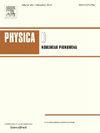基于高斯过程的贝叶斯学习用于时变非线性系统的低维表示
IF 2.7
3区 数学
Q1 MATHEMATICS, APPLIED
引用次数: 0
摘要
这项工作提出了一种数据驱动的方法,用于学习低维时间依赖的基于物理的代理模型,其预测被赋予不确定性估计。我们使用算子推理方法进行模型约简,该方法提出了通过最小化约简系统方程的残差来学习低维模型项作为状态空间数据和相应时间导数的回归的问题。标准算子推理模型对于时间上密集的精确训练数据表现良好,但当状态数据在时间上有噪声和/或稀疏时,产生稳定和准确的模型仍然是一个挑战。另一个挑战是缺乏对算子推理模型预测的不确定性估计。我们的方法通过将高斯过程替代品纳入算子推理框架来解决这些挑战,以(1)概率地描述状态预测中的不确定性,(2)获得具有量化不确定性的分析时间导数估计。该公式导致了广义最小二乘回归,并最终导致了用算子后验分布的封闭表达式概率描述的降阶模型。由此产生的概率代理模型将不确定性从观察到的状态数据传播到降阶预测。我们证明了该方法对于表示可压缩流动和非线性扩散反应过程的两个非线性偏微分方程的低维模型的构造是有效的,对于表示流行病学中室模型的非线性常微分方程的低维系统的参数估计也是有效的。本文章由计算机程序翻译,如有差异,请以英文原文为准。
Bayesian learning with Gaussian processes for low-dimensional representations of time-dependent nonlinear systems
This work presents a data-driven method for learning low-dimensional time-dependent physics-based surrogate models whose predictions are endowed with uncertainty estimates. We use the operator inference approach to model reduction that poses the problem of learning low-dimensional model terms as a regression of state space data and corresponding time derivatives by minimizing the residual of reduced system equations. Standard operator inference models perform well with accurate training data that are dense in time, but producing stable and accurate models when the state data are noisy and/or sparse in time remains a challenge. Another challenge is the lack of uncertainty estimation for the predictions from the operator inference models. Our approach addresses these challenges by incorporating Gaussian process surrogates into the operator inference framework to (1) probabilistically describe uncertainties in the state predictions and (2) procure analytical time derivative estimates with quantified uncertainties. The formulation leads to a generalized least-squares regression and, ultimately, reduced-order models that are described probabilistically with a closed-form expression for the posterior distribution of the operators. The resulting probabilistic surrogate model propagates uncertainties from the observed state data to reduced-order predictions. We demonstrate the method is effective for constructing low-dimensional models of two nonlinear partial differential equations representing a compressible flow and a nonlinear diffusion–reaction process, as well as for estimating the parameters of a low-dimensional system of nonlinear ordinary differential equations representing compartmental models in epidemiology.
求助全文
通过发布文献求助,成功后即可免费获取论文全文。
去求助
来源期刊

Physica D: Nonlinear Phenomena
物理-物理:数学物理
CiteScore
7.30
自引率
7.50%
发文量
213
审稿时长
65 days
期刊介绍:
Physica D (Nonlinear Phenomena) publishes research and review articles reporting on experimental and theoretical works, techniques and ideas that advance the understanding of nonlinear phenomena. Topics encompass wave motion in physical, chemical and biological systems; physical or biological phenomena governed by nonlinear field equations, including hydrodynamics and turbulence; pattern formation and cooperative phenomena; instability, bifurcations, chaos, and space-time disorder; integrable/Hamiltonian systems; asymptotic analysis and, more generally, mathematical methods for nonlinear systems.
 求助内容:
求助内容: 应助结果提醒方式:
应助结果提醒方式:


